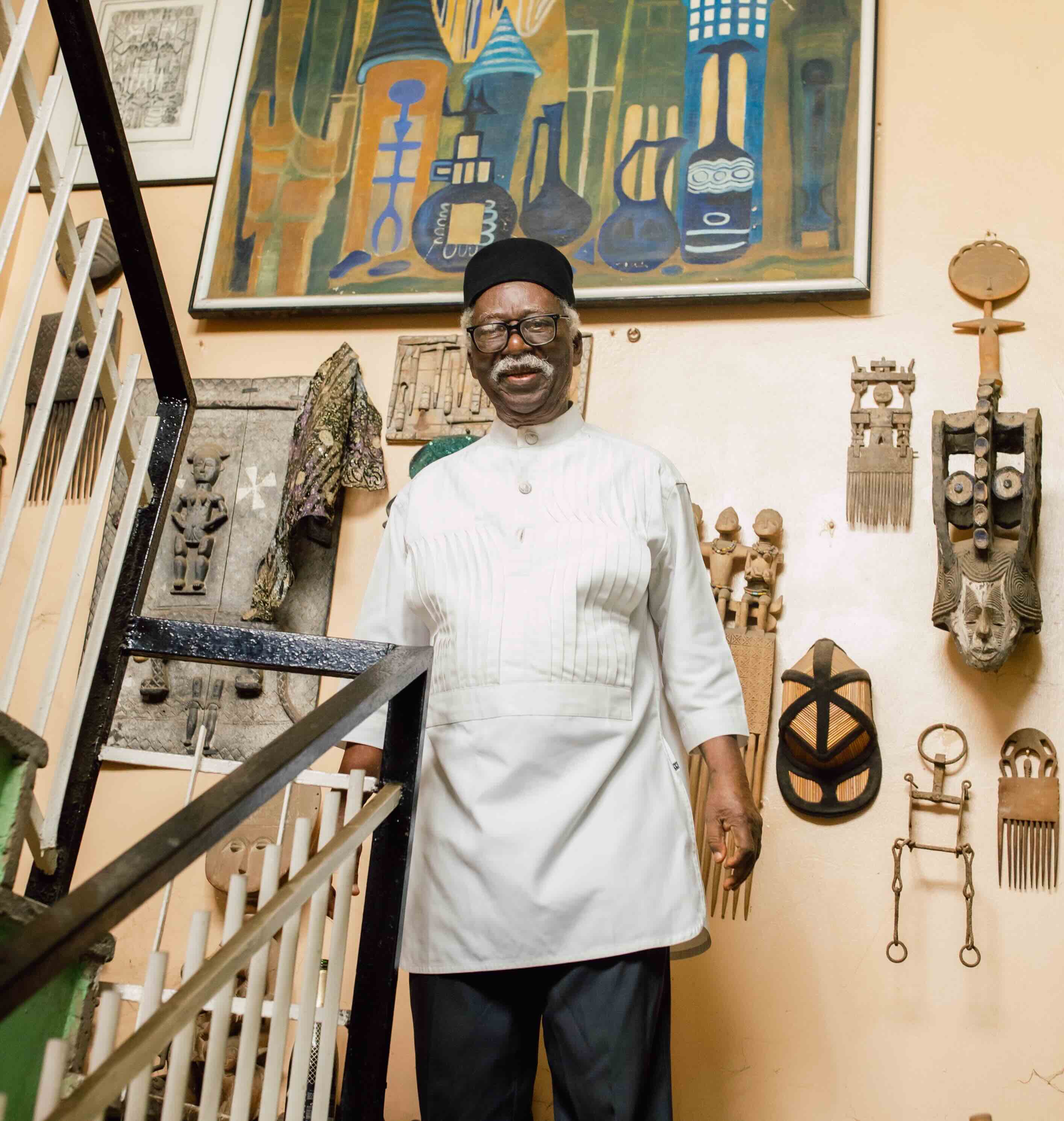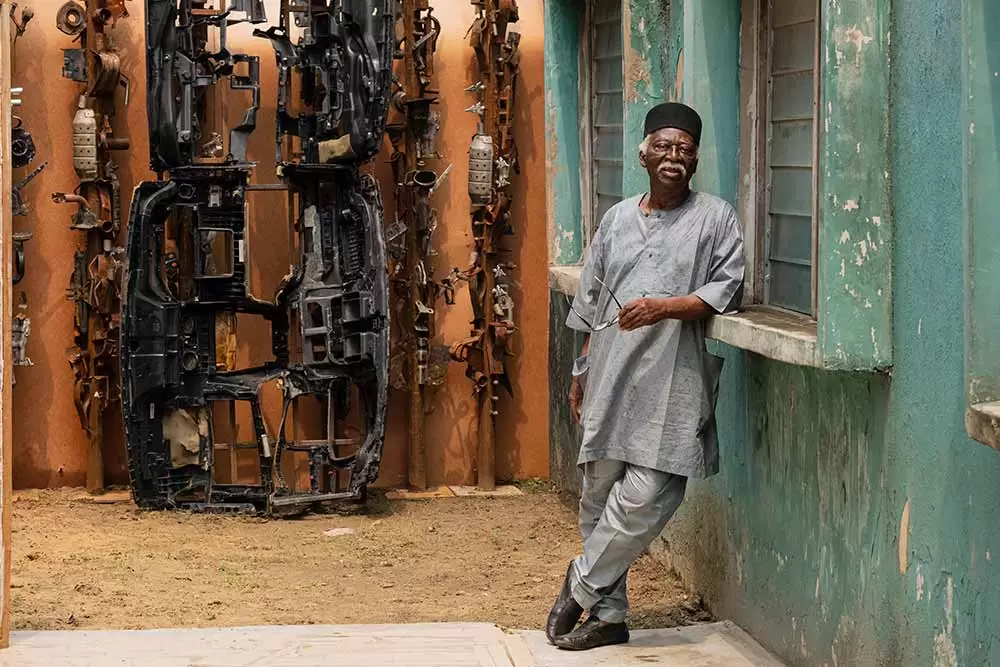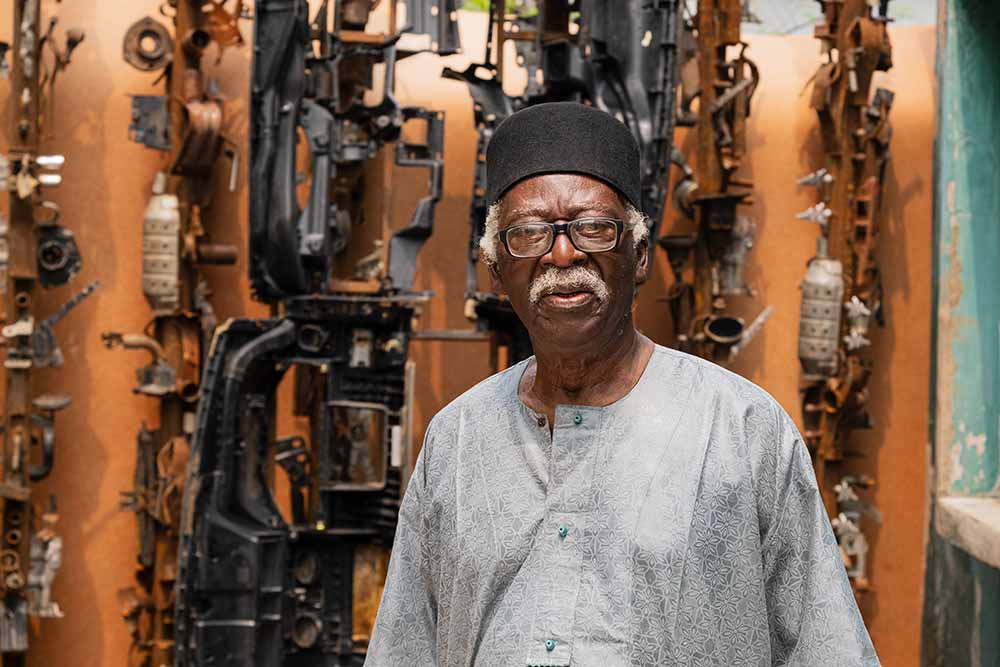
From the streets of Zaria to the walls of Tate Modern.
From the streets of Zaria to the walls of Tate Modern.
Not many artists have struck an unlikely chord the way a man who could teach a country how to make image and story speak the same language. That artist is Bruce Onobrakpeya. He is the living legend people point to when they talk about postcolonial Nigerian art. Born in Agbarha-Otor, Delta State in 1932, Onobrakpeya built a career that blends folklore, religion, technique, and invention, and now London’s Tate Modern is giving Nigerian modernism a major moment that reasserts his central place in the story.
Bruce’s story starts like many good ones, in classrooms and workshops. His early education at the Nigerian College of Arts, Science, and Technology (now Ahmadu Bello University) in Zaria exposed him to Western representational art. However, it was his involvement with the Zaria Art Society that ignited his passion for blending indigenous Nigerian aesthetics with modern techniques, giving birth to a unique artistic voice.

What makes Onobrakpeya’s work sing is technique plus imagination. He did not simply use printmaking tools, he made new ones. In the late 1960s he developed plastograph, a deep etching technique that became his signature. Later he refined metal foil deep etching and metal foil relief prints, inventing Ivorex to mimic the look of carved ivory without harming animals. He also developed Ibiebe, an ideographic script that folds Urhobo symbols and proverbs into abstract glyphs.
This innovation, along with his other explorations, showcased his commitment to pushing artistic boundaries. His series, The Mask and the Cross, reimagined Christian narratives through a Yoruba lens, challenging viewers to see familiar stories in a new light.

If you have seen Onobrakpeya in reproduction or in person, you know his work carries a layered density. A plastograph holds relief, shadow, and line like a memory box. Metal foil prints shimmer like ritual object and also read like modern relief sculpture. He borrowed from European printmaking then folded in Yoruba myth, Urhobo proverbs, Christian iconography, and the oral patterns of the Niger Delta. The result is a vocabulary only he could have written.
His reach is national and international. He helped found the Harmattan Workshop and the Bruce Onobrakpeya Foundation, platforms that trained younger artists and kept printmaking alive as a technique of resistance and identity. He showed in Venice, Dakar, New York, and at major museums across Europe and America. He has been honored with the UNESCO Living Human Treasures award and Nigeria’s top creative prizes. That recognition matters because it signals what curators and historians already know: Onobrakpeya helped define modern Nigerian visual language.
Which brings us to Tate Modern. The museum’s new show, Nigerian Modernism, situates the story of Nigerian art from early 20th-century portraiture to late 20th-century experiments, and Onobrakpeya features as a key figure in that arc. The exhibition foregrounds the Zaria movement, Ben Enwonwu’s national symbolism, the Oshogbo school’s spiritual modernity, and the push to make Nigerian art a language for history, identity, and independence. The Tate platform turns the spotlight on a line of artists who reshaped what modern art could be in Africa and the diaspora. Seeing Onobrakpeya there is not just fitting, it is corrective.
Why does this matter right now? First, the Tate show corrects a history that often flattens African modernism into folkloric stereotypes. Instead the exhibition shows artists wrestling with colonialism, faith, nationhood, and modernity, and Onobrakpeya’s prints are central to that argument. Second, the show gives UK and global audiences a chance to see the technical inventiveness behind what has sometimes been simplified as “African art.” Onobrakpeya’s plastographs and foil etchings make that inventiveness obvious, and they force viewers to pay attention to craft as a political act.
There is also an emotional thread to his work. Onobrakpeya is a maker of memory. He revisits the Biblical and the Urhobo, often layering Christian scenes with Yoruba aesthetic logic. He has said that those intersections reflect how Nigerians live belief, not in isolated categories but in overlap. His prints can feel like hymnals, like family albums, like maps of a culture that survived disruption and kept its visual language alive. Museums and collectors have taken note. His works appear in international collections and auction houses. That market attention is secondary to the work itself, but it signals growing global recognition of the depth of Nigerian modernism.

If you are new to Bruce Onobrakpeya, start with a plastograph or a metal foil etching. Look at how figures fold into geometric mark-making. Note the scriptural Ibiebe glyphs. Try to feel the mix of grief, humour, ritual, and ancestral memory in a single plate. Then when you see him in Tate Modern’s Nigerian Modernism show, you will understand what generations of Nigerian artists meant when they said they were building a modern art that belonged to the continent and to the world.
Onobrakpeya turned technique into language, and language into legacy. He taught, invented, curated, and kept the workshop alive so that young artists could stand taller. In the Tate’s galleries his work sits among peers like Ben Enwonwu and El Anatsui, and together they tell a story of modernism that is not a copy of Europe but a rebuke to the idea that modernity only travels one way. For anyone who cares about art that holds history and heart, Bruce Onobrakpeya is essential viewing.
Comments